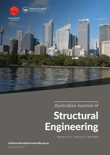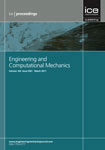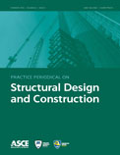
Australian Journal of Structural Engineering
Scope & Guideline
Exploring the Frontiers of Engineering Excellence
Introduction
Aims and Scopes
- Structural Performance and Safety Assessment:
The journal emphasizes the evaluation and improvement of structural performance under various conditions, including seismic, wind, and fire loads. This includes experimental and numerical studies to assess safety and reliability. - Innovative Materials and Sustainable Practices:
Research on alternative materials and sustainable practices is a core area, promoting the use of recycled and environmentally friendly materials in construction, such as geopolymer concrete and fiber-reinforced composites. - Advanced Analytical and Numerical Methods:
The journal showcases advancements in analytical and numerical modeling techniques, including finite element methods, machine learning applications, and probabilistic assessments to enhance structural design and evaluation. - Resilience and Risk Mitigation:
Research aimed at improving the resilience of structures against natural disasters and environmental impacts is a focal point, with a strong emphasis on risk assessment and management strategies. - Infrastructure Management and Rehabilitation:
The journal also covers topics related to the maintenance, rehabilitation, and management of existing structures, ensuring longevity and safety in infrastructure systems.
Trending and Emerging
- Smart Materials and Technologies:
Recent publications increasingly focus on the integration of smart materials and technologies in structural engineering, such as self-healing concrete and advanced composites, showcasing their potential for enhancing structural performance. - Machine Learning and Data-Driven Approaches:
There is a growing trend towards utilizing machine learning and artificial intelligence for predicting structural behaviors and optimizing designs, indicating a shift towards data-driven methodologies in engineering. - Sustainable Engineering Practices:
The journal is seeing a surge in research dedicated to sustainable engineering practices, including the use of waste materials and environmentally friendly construction techniques, reflecting a global focus on sustainability. - Seismic Resilience and Performance-Based Design:
An increasing number of studies concentrate on seismic resilience and performance-based design, emphasizing the need for structures to withstand earthquakes and other dynamic loads effectively. - Infrastructure Aging and Rehabilitation:
Emerging research themes focus on the assessment and rehabilitation of aging infrastructure, highlighting the importance of maintaining and upgrading existing structures to meet current standards and safety requirements.
Declining or Waning
- Traditional Material Studies:
There has been a noticeable decline in studies focused solely on traditional materials such as plain concrete and steel without innovative enhancements. The trend is moving towards more sustainable and composite materials. - Basic Structural Analysis Techniques:
Research that relies on conventional structural analysis methods without incorporating modern computational or machine learning techniques appears to be waning, as the field increasingly values advanced methodologies. - Historical and Heritage Structures:
While still important, there has been less emphasis on the study of historical structures in recent publications. This may indicate a shift towards more contemporary engineering challenges and technologies. - Generalized Case Studies:
The journal has moved away from generic case studies that do not provide new insights or methodologies, favoring more targeted research that addresses specific engineering problems or innovations.
Similar Journals

Proceedings of the Institution of Civil Engineers-Engineering and Computational Mechanics
Exploring the Intersection of Engineering and Computational MechanicsProceedings of the Institution of Civil Engineers - Engineering and Computational Mechanics is a prestigious journal published by Emerald Group Publishing Ltd, dedicated to advancing the fields of civil and structural engineering, as well as mechanics of materials. With an ISSN of 1755-0777 and E-ISSN 1755-0785, this journal serves as a critical platform for disseminating innovative research and practical insights from 2009 through 2024. As part of its commitment to academic rigor, it is categorized in the Q4 quartile for both civil and structural engineering and mechanics of materials, reflecting a unique position in the scholarly community. The journal is essential for professionals, researchers, and students aiming to stay informed on current trends, methodologies, and applications in engineering and computational mechanics. By engaging with this publication, readers gain access to crucial findings that contribute to the advancement of infrastructure and materials science, vital for developing resilient and sustainable engineering solutions.

Electronic Journal of Structural Engineering
Fostering Collaboration in Structural Engineering AdvancementsThe Electronic Journal of Structural Engineering (ISSN: 1443-9255), published by EJSE INT LTD, serves as a vital platform for disseminating innovative research and developments in the field of structural engineering. Since its inception in 2001, the journal has evolved to embrace an Open Access model starting in 2022, ensuring that cutting-edge findings are freely accessible to researchers, professionals, and students worldwide. Housed within the reputable Department of Infrastructure Engineering at the University of Melbourne, Australia, the journal focuses on a wide range of topics related to civil and structural engineering, positioning itself within the Q4 category on the 2023 Scopus rankings. While its H-index and detailed scope data are currently unavailable, the journal's commitment to quality research is evident through its continuous publication and engagement with the global academic community. With significant implications for contemporary engineering practices, The Electronic Journal of Structural Engineering not only fosters scholarly discourse but also encourages practical applications of structural engineering advancements.

Practice Periodical on Structural Design and Construction
Connecting Theory and Practice in Civil EngineeringPractice Periodical on Structural Design and Construction, published by the American Society of Civil Engineers (ASCE), is a vital resource within the fields of civil and structural engineering. With an ISSN of 1084-0680 and an E-ISSN of 1943-5576, this journal aims to disseminate innovative research and practical applications that enhance the design and construction process. Recognized in the 2023 Scopus rankings with commendable placements across categories, including a Q2 designation in Building and Construction, this journal serves as a platform for discourse on the latest advancements and case studies in structural engineering. Though not an Open Access publication, it continues to facilitate the exchange of knowledge and expertise among researchers, professionals, and students engaged in the built environment. The editorial board encourages submissions that contribute to the understanding of sustainable practices, innovative technologies, and effective construction methodologies to meet the evolving needs of infrastructure development.

Proceedings of the Institution of Civil Engineers-Ground Improvement
Advancing Ground Improvement for Sustainable InfrastructureProceedings of the Institution of Civil Engineers-Ground Improvement is a distinguished journal published by EMERALD GROUP PUBLISHING LTD, dedicated to advancing knowledge and research in the fields of Building and Construction, Geotechnical Engineering, Mechanics of Materials, and Soil Science. With an ISSN of 1755-0750 and an E-ISSN of 1755-0769, this journal has been a vital platform for disseminating innovative research since its inception in 2008. With an impact factor placing it in the Q3 category across multiple engineering disciplines, it ranks favorably in Scopus, ensuring visibility and recognition among scholars globally. The journal offers open access options, allowing for broader dissemination of research findings. Targeting researchers, professionals, and students alike, it aims to foster discussions on ground improvement technologies and methodologies that are essential for sustainable infrastructure development. As it continues to converge its focus until 2024, the Proceedings stands as an imperative resource for those seeking to elevate their understanding and contribute to the ever-evolving field of civil engineering.

Earthquakes and Structures
Transforming challenges into solutions in seismic design.Earthquakes and Structures is a prestigious academic journal published by TECHNO-PRESS, dedicated to the field of Civil and Structural Engineering. Since its inception in 2010, this journal has provided a platform for innovative research and practical applications, addressing critical challenges related to seismic activities and their impact on infrastructure. With an ISSN of 2092-7614 and an E-ISSN of 2092-7622, it is indexed in top databases, reflecting its commitment to quality and relevance, as indicated by its Q3 quartile ranking in 2023. The journal encompasses a wide range of topics, from theoretical investigations to real-world case studies, appealing to researchers, professionals, and students alike. By fostering interdisciplinary collaboration and disseminating cutting-edge findings, Earthquakes and Structures plays an essential role in advancing knowledge and practices in earthquake engineering, enhancing global resilience against seismic threats.

ADVANCES IN STRUCTURAL ENGINEERING
Pioneering Innovations in Structural EngineeringADVANCES IN STRUCTURAL ENGINEERING, published by SAGE PUBLICATIONS INC, is a leading journal dedicated to the advancement of knowledge in the fields of Building and Construction, as well as Civil and Structural Engineering. With a solid impact factor and a commendable Scopus ranking (Rank #60 in Building and Construction, Rank #105 in Civil and Structural Engineering), this journal stands at the forefront of academic research, providing a platform for high-quality articles that contribute significantly to the discipline. Covering a range of topics from innovative construction techniques to sustainable engineering practices, the journal aims to foster collaborative dialogue among researchers, industry professionals, and students alike. As of 2023, it boasts impressive category quartiles, ranking Q1 in Building and Construction and Q2 in Civil and Structural Engineering. ADVANCES IN STRUCTURAL ENGINEERING is a vital resource for those looking to stay abreast of emerging trends and groundbreaking developments in structural engineering, promoting an environment of continuous learning and application of best practices. With a convergence of research from 1999 to 2024, the journal not only emphasizes theoretical frameworks but also bridges the gap between academia and practical application in engineering projects.

International Journal of Protective Structures
Building resilience through insightful research and design.International Journal of Protective Structures is a leading peer-reviewed publication dedicated to advancing the field of protective structures, focusing on innovative designs and methodologies relevant to future applications in safety, risk management, and materials engineering. Published by SAGE Publications Ltd in the United Kingdom, this journal has established itself as a vital resource for researchers, professionals, and students alike, notably holding a strong presence in Scopus rankings within its categories—including Q2 in Building and Construction, Mechanics of Materials, and Safety, Risk, Reliability and Quality. The journal aims to disseminate high-quality research from 2010 to 2024, emphasizing both theoretical and practical implications in its scope. By offering crucial insights into protective structural development and resilience against various risks, International Journal of Protective Structures plays an important role in shaping the discourse within its fields. With an ongoing commitment to accessibility and knowledge sharing, this journal is indispensable for those striving to innovate and implement safe structural engineering practices.

Structural Integrity and Life-Integritet I Vek Konstrukcija
Enhancing Safety and Reliability in Construction.Structural Integrity and Life - Integritet I Vek Konstrukcija is a prominent open-access journal dedicated to advancing the fields of Civil and Structural Engineering, Mechanics of Materials, and Safety, Risk, Reliability, and Quality. Published by the SOC STRUCTURAL INTEGRITY & LIFE, this journal has been disseminating high-quality research since 2001 from its base in Belgrade, Serbia. The journal's commitment to open access ensures that vital research is freely accessible to a global audience, fostering collaboration and innovation within the academic community. With an impressive categorization in the 2023 quartiles, including Q2 in Metals and Alloys and Q3 in related fields, Structural Integrity and Life stands as a vital resource for researchers, professionals, and students striving to enhance understanding and applications in structural integrity and material performance. The journal invites contributions that address critical issues in the field, pushing the boundaries of knowledge and practical applications, and welcomes both empirical studies and theoretical discussions that can drive forward the next generation of engineering solutions.

International Journal of GEOMATE
Connecting theory and practice in geotechnical and environmental engineering.The International Journal of GEOMATE, published by GEOMATE INT SOC based in Japan, is a pivotal resource for scholars and practitioners in the fields of Building and Construction, Environmental Engineering, Geotechnical Engineering, and Soil Science. Established in 2011 and continuing to set the standard in its focus areas, this journal serves as a platform for innovative research and practical applications, with contributions that significantly enhance the understanding and development of sustainable engineering practices. With its current classification in the Q3 quartile across multiple categories, it strives to disseminate critical knowledge and foster dialogue among a diverse audience, including researchers, industry professionals, and students. Though operating under a traditional subscription model, the journal's emphasis on rigorous peer review and high-quality publications ensures a substantial impact factor, further reinforcing its reputation in academia. Spanning from 2011 to 2024, the International Journal of GEOMATE invites contributions that advance the knowledge frontier and address contemporary challenges in engineering and environmental science.

Civil Engineering Infrastructures Journal-CEIJ
Building bridges between research and practice in civil engineering.Civil Engineering Infrastructures Journal (CEIJ), published by the University of Tehran, College of Engineering, is a premier platform dedicated to advancing the field of civil and structural engineering. With an ISSN of 2322-2093 and an E-ISSN of 2423-6691, CEIJ has been an Open Access journal since 2013, ensuring that critical research is accessible to a global audience. While it currently holds a Q4 category ranking in Civil and Structural Engineering as per the 2023 quartiles, the journal is committed to enhancing its reputation and impact within the academic community. Researchers, professionals, and students will find valuable insights in its compelling articles, which cover a wide array of topics pertinent to civil engineering infrastructures. The journal aims to foster innovative ideas and solutions that address contemporary challenges in the industry. As a publication rooted in Iran but reaching an international readership, CEIJ serves as a significant conduit for disseminating impactful research in the ever-evolving landscape of civil engineering.